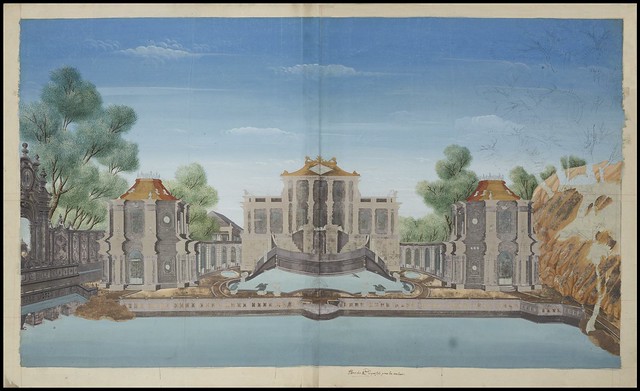A Suite of Twenty Engravings of the Yuan Ming-Yuan Summer Palaces and Gardens of the Chinese Emperor Ch'ien Lung. (published 1786) at NYPL Digital Gallery.
Giuseppe Castiglione (1688-1766) received artistic training from Carlo Cornara and Andrea Pozzo in Milan and then took his religious vows. As part of the Jesuit evangelical aspirations in China, Castiglione was sent there as a missionary when he was 27 years old.
He was to serve for 51 years until his death as court painter under his Chinese name of Lang Shih-ning to 3 Emperors during the last Chinese (Quing) dynasty. He introduced the ideas of renaissance perspective, anatomical accuracy and the use of light and shade which had a significant and lasting influence on Chinese art. He himself incorporated Chinese artistic techniques into his own works.
Emperor Quianlong (Ch'ien Lung) contributed to the vast Summer Palace region in Beijing by having Giuseppe Castiglione design buildings for the Yuanmingyuan or Old Summer Palace. Unfortunately, French and English forces plundered Yuanmingyuan in 1860 and only ruins remain. The beautiful illustrations above were published 20 years after Castiglione's death but I'm not sure if the engraving work was by done by him or someone else.
- The Ruins of the Yuanmingyuan (The Garden of Perfection and Light)
- Giuseppe Castiglione and Court Art in Qianlong's Reign of Qing Dynasty
- China: The Three Emperors 1662-1795 at the Royal Academy of Art recently and review at Jesuit.org.uk.
- A Jesuit at the Court of the Chinese Emperors - a review of The Three Emperors but with a decent, if brief biography of Castiglione and his contriubtions to the Yuanmingyuan.
- Some Castiglione 'art' links
- Yuanmingyuan; photographs of the ruins. There is talk of restoration. [photographs of the Summer Palace]
- UPDATE (June 2012) : Rylands Library in Manchester has a volume that is either identical to the one seen above or is an expanded edition : 'Twenty views of the European Palaces in the Garden of Perfect Brightness' (thumbnail page) -- note that very large images are accessible. [VIA]







No comments:
Post a Comment